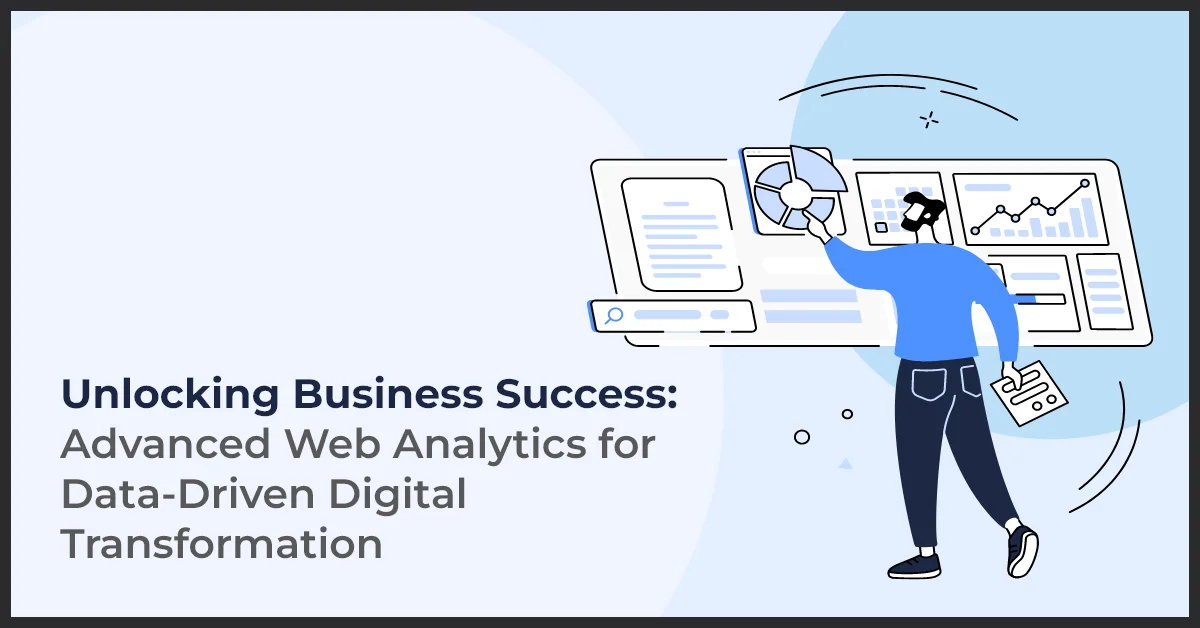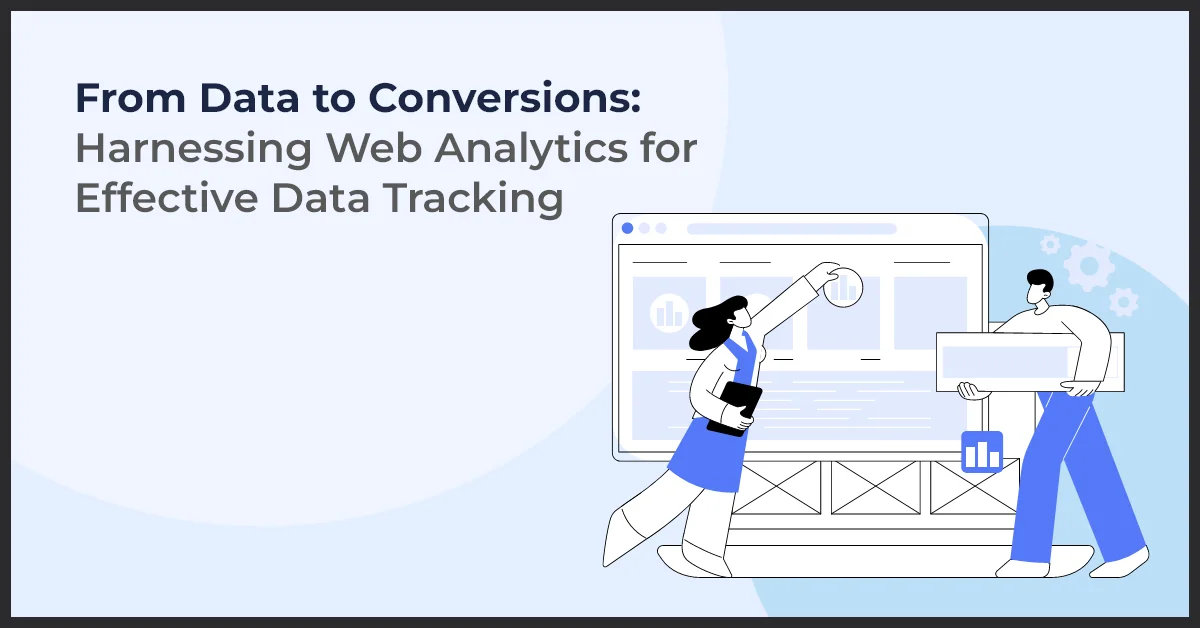Mastering Web Analytics: Tools, Techniques, and Best Practices

Published on: December 29, 2023
Updated on: June 26, 2024
1328 Views
- Web Analytics
12 min read
Ever wonder what your online visitors are up to when they’re on your website? Understanding their journey, preferences, and areas of interaction is important for effective decision-making and improving your web presence. But how do you uncover these insights? That's where you need web analytics—a powerful tool that turns user data into strategic insights.
The Internet is a world where every click counts, web analytics is your guide to decoding your users’ behavior. It helps you evaluate your website's performance, identify strengths, and spot areas for improvement. Armed with this knowledge, businesses gain the power to optimize the user experience, foster greater engagement, and drive conversions through their website.
In this blog post, we will uncover the best web analytics tools, techniques, and best practices to utilize.
An Overview of Popular Web Analytics Tools
With so many options on the market, finding the right web analytics tool can be a challenge. We've picked out the best web analytics tools to make things simpler for you. Let's take a look at what each of them offers and how they can help your business grow with smart, data-driven decisions.
1. Google Analytics
Google Analytics, a powerhouse by Google, stands out as one of the most comprehensive web analytics tools. It excels in providing quantitative user and customer data across various devices and platforms. Businesses leverage Google Analytics to gain deep insights into website traffic, user behavior, and performance.
Key Features of Google Analytics are:
- Robust tracking of quantitative data, from sessions to bounce rates.
- Integration with the Google Marketing Platform for a unified data view.
- Advanced event tracking is available for both websites and apps.
- Seamless integration with other Google tools like AdWords and Search Console.
2. Mixpanel
Mixpanel, a self-serve product analytics platform, is designed to empower businesses by converting, engaging, and retaining users effectively. It particularly shines in providing insights into product usage, visualizing user journeys, and enhancing customer retention. Its robust product analytics capabilities make this tool equally suitable for both B2C and B2B businesses.
Key Features of Mixpanel are:
- In-depth insights into how products are used and feature popularity.
- Retroactive funnel building for visualizing user drop-offs and conversion rates.
- Comprehensive quantitative and qualitative data analysis.
- Integration with Hotjar for additional qualitative insights.
3. Adobe Analytics
Adobe Analytics is a traditional web and marketing analytics tool integrated into the Adobe Experience Platform. Positioned as an enterprise alternative to Google Analytics, it provides actionable insights by collecting and measuring data from various channels.
Key Features of Adobe Analytics are:
- Comprehensive data collection from multiple channels for a holistic view.
- Customer segmentation for understanding diverse behavior patterns.
- Leveraging AI, machine learning, and automation for predictive insights.
- Ideal for scaling businesses.
4. Matomo (formerly Piwik)
Matomo, as an open-source web analytics tool, stands out for its unwavering commitment to data protection and privacy. With 100% data ownership, Matomo ensures privacy compliance with strict regulations like GDPR, HIPAA, CCPA, LGPD, and PECR, offering a unique blend of analytics prowess and privacy assurance for businesses.
Key Features of Matomo are:
- Complete data ownership for user privacy.
- GDPR-compliant analytics tool.
- Comprehensive web analytics data, including behavioral data and SEO performance.
5. DiGGrowth
DiGGrowth distinguishes itself as a dynamic marketing analytics platform tailored for businesses seeking comprehensive insights into their online performance. Focused on user-centric analytics, it provides a suite of tools to enhance understanding of website traffic, user behavior, and overall digital effectiveness.
Key Features of DiGGrowth:
- Comprehensive insights focused on user behavior.
- Tracking and analyzing conversions effectively.
- Real-time reporting features for the most relevant marketing data.
Setting Up and Configuring Web Analytics Tools
A thoughtful comparison of these tools will guide you in selecting the tool aligned with your objectives. Once you select the tool that fits your needs, the next step is to set it up.
- Integrate the chosen tool into your website or web application, following the provided instructions and configuring the settings.
- Identify measurable values like page load time, bounce rate, and conversion rate to gauge the effectiveness of your objectives.
- Utilize reports, dashboards, and visualizations to track how your website is performing against your established KPIs.
- Delve deeper into your data using tools and techniques like filters, comparisons, trends, and experiments to uncover insights.
- Implement changes based on your analysis, prioritizing areas for improvement and ensuring continuous iteration for optimal web performance.
Understanding Key Metrics and KPIs
KPIs are like guideposts, helping you understand the big picture by simplifying the loads of data collected. These special markers not only give you instant insights but also act as alarms, telling you if something's not right and pointing you in the right direction. While an array of KPIs exists, a wisely chosen suite ensures a comprehensive yet manageable assessment of your website's effectiveness. Here are some important web-based KPIs to consider:
1. Conversion Rate:
This metric quantifies the proportion of visitors who take a predefined action, be it making a purchase, subscribing to a newsletter, or completing a form. A higher conversion rate signifies a website effectively compelling users to perform desired actions.
2. Page Views:
This metric simply counts the number of visitors that visited a page over a specified period. A surge in page views indicates heightened user interest and interaction with the website's content.
3. Absolute Unique Visitors:
Understanding the actual audience is pivotal and unique visitors shed light on the distinct individuals visiting a site. This metric avoids counting repeat visits, providing a clear picture of a website's true reach and user base.
4. New vs. Returning Visitors:
Understanding your website's audience involves looking at new and returning visitors. This crucial analysis helps tailor strategies to attract and retain diverse audience segments. By figuring out the proportion of first-time visitors versus those returning, you can create targeted approaches for a more effective online presence.
5. Bounce Rate:
The bounce rate reveals the number of visitors who navigate away after viewing a single landing page of the site. A high bounce rate prompts a critical examination of the landing page's relevance and alignment with user expectations.
6. Abandonment Rate:
As users move through planned conversion funnels, some might stray from the intended path. The abandonment rate brings attention to this, showing the percentage of visitors who initiate a conversion funnel but leave before finishing the desired action. Recognizing these points is vital for enhancing user journeys.
7. Cost per Conversion (CPC):
The cost per conversion metric calculates the total cost of advertising divided by the number of conversions. A lower CPC indicates efficient utilization of resources, ensuring that marketing endeavors yield tangible results.
Analyzing Website Traffic and User Behavior
Having set up the analytics tools and identified KPIs, it's time to actively explore your website's traffic and user behavior. This critical phase requires delving into the intricacies of user interactions, understanding their journeys, and extracting valuable insights. Here is how you can analyze website traffic and user behavior through web analytics:
Exploring Traffic Sources
Start by examining the sources of your website's traffic. Web analytics tools typically categorize traffic into different sources, such as:
- Organic Search: Visitors who find your site through search engines.
- Direct Traffic: Users who type your website URL directly into their browsers.
- Referral Traffic: Visitors who come to your site from external links on other websites.
- Social Media Traffic: Users arriving from various social media platforms.
Understanding the distribution of traffic across these sources helps you identify the most effective channels for attracting visitors. This knowledge is crucial for refining your marketing strategies and allocating resources appropriately.
Analyzing User Behavior
- User Journeys: Utilize analytics tools to visualize user journeys on your website. Identify common paths users take through your site and pinpoint areas where they might drop off. Analyze the effectiveness of your calls-to-action and the user flow through conversion funnels.
- Page Engagement: Examine page views, time spent on each page, and bounce rates. Identify high-performing pages and understand what keeps visitors engaged. Analyze the content and structure of pages with high bounce rates to make improvements.
- Demographic Insights: Leverage tools that provide demographic data to better understand your audience. Identify the geographical locations, devices, and browsers your users are using. Tailor your content and user experience based on demographic insights.
- Event Tracking: Implement event tracking to monitor specific interactions on your site, e.g., clicks, downloads, and video views. Analyze the impact of these interactions on overall user engagement and conversion rates. Use this data to optimize the placement and design of key elements on your website.
Tracking Conversions and Goal Completions
Understanding how well your website converts visitors into customers is crucial for optimizing performance and driving tangible results. Conversion tracking involves monitoring the actions users take on your site that align with your business objectives. Tracking conversions—whether it's a purchase, form submission, newsletter signup, or any desired action—provides vital insights into your website's effectiveness in engaging users and achieving goals. Here are some best practices for conversion tracking:
1. Multi-Channel Attribution:
Understand the entire user journey by implementing multi-channel attribution models. This provides insights into the various touchpoints that contribute to conversions.
2. Value Assignments:
Assign values to different conversion goals to quantify their impact on your business. This helps prioritize goals based on their contribution to overall success.
3. Funnel Visualization:
Utilize funnel visualization tools to track the step-by-step journey users take towards conversion. Identify potential drop-off points and optimize the funnel for better conversion rates.
4. Custom Alerts:
Set up custom alerts to receive notifications when there are significant changes in conversion rates. This allows for timely responses and adjustments to your strategy.
5. A/B Testing for Optimization:
Conduct A/B testing to experiment with different elements on your website and determine the most effective combinations for driving conversions.
Utilizing Segmentation and Filtering for Deeper Insights
Understanding user behavior goes beyond surface-level insights. The use of segmentation and filtering is important to unravel the intricacies of your data and extract valuable insights. Here's a closer look at how you can leverage these techniques to gain deeper and more actionable insights:
1. Demographic Segmentation:
Segment users based on demographics such as age, gender, location, and devices used. Identify specific demographic groups that show higher engagement or conversion rates.
2. Behavioral Segmentation:
Segment users based on actions such as page views, time spent on site, or specific interactions. Identify high-value segments and tailor content or marketing strategies accordingly.
3. Traffic Source Filtering:
Filter users based on traffic sources like organic search, direct, referral, or social media. Understand the performance of each traffic source and optimize your marketing efforts.
A/B Testing and Optimization Strategies
Along with gaining web analytics insights and modifying your approach based on the data, staying ahead requires a commitment to continuous improvement. A/B testing and optimization strategies allow you to refine your website's elements for maximum impact. Here's how you can utilize A/B testing and optimization strategies effectively:
1. Sequential Testing:
Opt for sequential testing to assess the effects of changes over time. This approach allows you to refine your strategies based on evolving user behavior and preferences.
2. Segmented Analysis:
Segment your audience during A/B testing to gain insights into how variations perform among different user groups. This targeted analysis helps tailor strategies for specific demographics, optimizing your overall approach.
3. Mobile Responsiveness:
Prioritize mobile responsiveness in A/B tests to accommodate the diverse range of devices users may utilize. Ensuring a seamless experience across different platforms enhances the reliability and effectiveness of your testing.
Optimization Strategies After A/B Testing
Use data-driven insights from A/B testing to optimize your website effectively. Regularly monitor your website's performance, focusing on improving page loading speed—a crucial factor for user experience and conversion rates. Keep your content relevant to meet evolving user expectations. Implement personalized strategies based on user behavior to boost engagement.
Reporting and Data Visualization Best Practices
Apart from cutting-edge tools and optimization strategies, excellence also demands effective reporting and data visualization practices. These practices help you report your data effectively, ensuring its clarity and comprehensiveness so you can take effective action. Below are the best reporting and data visualization practices to follow:
1. Clarity is Key:
Ensure that your reports are well organized and follow a logical flow. Clearly label metrics and provide context for better understanding. Visual elements, such as charts and graphs, should be intuitive and easily interpretable.
2. Customized Dashboards:
Tailor your dashboards to align with your specific objectives and KPIs. A clutter-free dashboard that showcases the most relevant metrics at a glance enhances the efficiency of decision-making.
3. Comparisons for Context:
Include comparative data to provide context for your metrics. Whether comparing performance against previous periods or benchmarking against industry standards, these comparisons offer valuable insights into the effectiveness of your strategies.
4. Data Accuracy Assurance:
Prioritize data accuracy and consistency in your reporting. Regularly audit and verify data sources to maintain the integrity of your analytics. Reliable data forms the foundation for sound decision-making.
Conclusion
The journey of web analytics is all about leveraging your website's data for online success. Your website's performance is not merely a collection of statistics. It's a dynamic narrative that unfolds through real-time insights. By harnessing the power of web analytics tools, you gain the means to understand user behavior, enhance engagement, and fortify your digital foothold.
Don't let your website get lost in the vast internet. In a world where every click matters, turn insights into action, ensuring your website not only survives but thrives. Embrace the power of web analytics to propel your online presence to new heights with confidence and purpose.Ready to Harness the Potential of Web Analytics? Let’s Talk!
Our team of experts would love to assist. Drop a line at info@growthnatives.com and we will get back to you.
Frequently Asked Questions
Discover essential metrics to track with web analytics, including traffic sources, page views, bounce rates, average session duration, conversion rates, goal completions, e-commerce transactions, and return on investment (ROI).
Understand how businesses use web analytics to gain insights into user behavior, identify areas for improvement, optimize website content and design, enhance user experience, increase conversions, and achieve business objectives.
Stay informed about emerging trends in web analytics, including the increasing use of artificial intelligence and machine learning, predictive analytics, real-time data analysis, and the growing importance of cross-device and cross-channel tracking.
Understand the impact of data privacy regulations like GDPR on web analytics, including the need for user consent, anonymizing data, and implementing privacy-friendly tracking methods to ensure compliance and protect user information.
Explore the integration capabilities of web analytics tools with other marketing platforms, such as CRM systems, email marketing software, social media platforms, and advertising networks, to provide a holistic view of your marketing efforts and customer journey.
Explore best practices for analyzing web analytics data, including setting clear objectives, segmenting your audience, using data visualization tools, regularly reviewing and updating your metrics, and leveraging A/B testing to optimize website performance.
Identify common challenges in web analytics, such as data accuracy, integrating multiple data sources, dealing with large data sets, and ensuring privacy compliance, along with strategies to address these challenges effectively.



